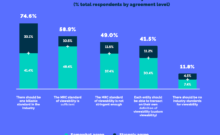The following is a guest post from Michael Tiffany, president and co-founder of White Ops .
It used to be easy to tell when non-human traffic was sapping your ad dollars. Until recently, bots almost exclusively lived in data centers and performed the same actions at the exact same time. A quick glance at visitor behavior would tell you whether you were being targeted by scammers.
But today’s bots are harder to spot because they’re explicitly designed to look like humans. Over 75% of ad fraud comes from bots that live on residential computers, allowing them to use real human IP addresses, copy their hosts’ purchase and browser history and even mimic their keyboard strokes and mouse movements.
In spite of these bots’ best efforts to hide themselves, their activity isn’t completely undetectable. We know that certain behaviors and metrics increase a campaign’s vulnerability to fraud, so you should be extra wary of a bot problem if any of the following four statements ring true:
1.) Your fraud rates stay the same between October and January
There is a common misconception among marketers that fraud affects all campaigns equally across the year. This is just not true. Fraud rates rise when there is a mismatch between ad supply and demand. This mismatch is especially pronounced during the holiday season, when advertisers pour much of their digital ad budget into campaigns vying for the attention of holiday shoppers.
As it turns out, CPM and internet browsing don’t increase that much over the holidays. So, if your traffic is spiking, it’s more than likely that bots are filling the gap. Your ad fraud solution should be detecting more fraudulent activity during peak periods — if it isn’t, it’s almost certainly letting bots slip through the cracks.
Read More at The Original Article: www.marketingdive.com









